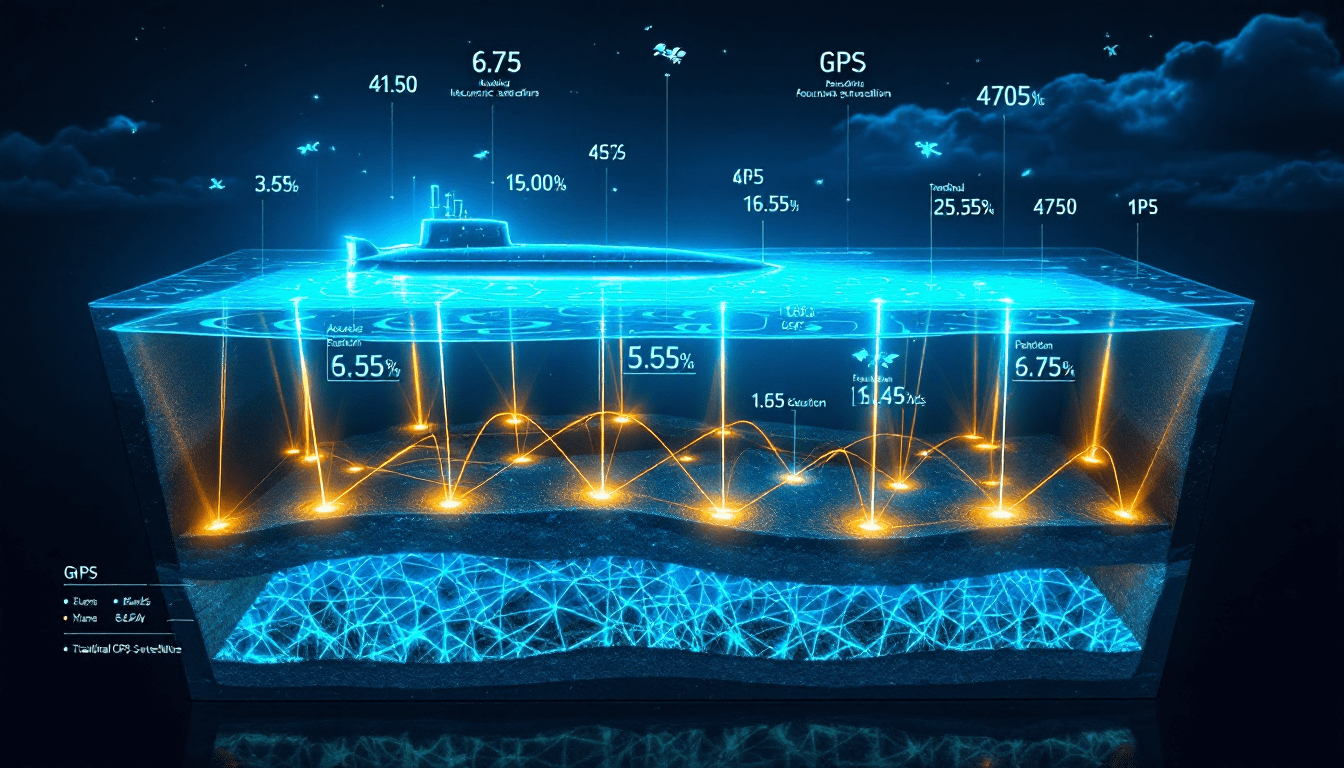Underwater GPS
Advanced acoustic beacon networks could theoretically achieve centimetre-precise underwater navigation at 6,000-metre depths through AI-compensated sound propagation models, potentially transforming submarines, offshore engineering and ocean science.

The ocean depths remain humanity's last navigational blind spot, where conventional GPS signals cannot penetrate more than a few centimetres beneath the waves. This fundamental limitation constrains underwater operations from submarine navigation to offshore engineering, forcing reliance on dead reckoning and surface support vessels. The breakthrough could arrive through acoustic positioning networks that would transform sound waves into precise three-dimensional coordinates, potentially achieving centimetre-level accuracy at depths exceeding 6,000 metres.
British scientists at Southampton's National Oceanography Centre are developing theoretical frameworks for advanced sonar arrays that could overcome the physical constraints plaguing underwater navigation for decades. These proposed systems would employ networks of seafloor transponders emitting precisely-timed acoustic pulses at frequencies between 8 and 16 kilohertz, creating an underwater constellation analogous to GPS satellites. Advanced signal processing algorithms would need to compensate for temperature gradients, salinity variations, and pressure effects that distort sound propagation through the water column.
The engineering challenge would lie in synchronising these acoustic beacons to atomic clock precision whilst accounting for the ocean's constantly shifting acoustic properties. Unlike electromagnetic waves travelling at a constant speed through vacuum, sound velocity in seawater varies from 1,450 to 1,550 metres per second depending on depth, temperature, and salinity. Future machine learning systems could theoretically model these variations in real-time, transforming chaotic underwater acoustics into reliable positioning data.
The Physics of Acoustic Positioning
Sound propagation through seawater follows complex physics fundamentally different from radio waves in air. The speed of sound depends on three primary variables according to the UNESCO equation: temperature contributes approximately 4.6 metres per second per degree Celsius, salinity adds 1.34 metres per second per practical salinity unit, and pressure increases velocity by 1.6 metres per second per 100 metres of depth. These variations create curved propagation paths as sound waves refract through water layers of varying density.
The theoretical breakthrough in underwater GPS would emerge from deploying vast arrays of acoustic transponders on the seafloor, each containing caesium atomic clocks that would need to maintain synchronisation to within nanoseconds despite crushing pressure and near-freezing temperatures. When an underwater vehicle or diver required positioning, it would transmit an acoustic interrogation pulse received by multiple seafloor beacons. Each beacon would respond with a coded acoustic signature containing its precise location and the exact time of signal reception.
The vehicle's onboard processor would calculate position through multilateration, measuring the time delays between transmitted and received signals. However, unlike GPS where signal travel times remain predictable, underwater acoustic signals would traverse constantly changing media. British researchers are working on theoretical adaptive ray-tracing algorithms that could model sound propagation paths in real-time, incorporating data from conductivity-temperature-depth sensors distributed throughout the water column.
The most sophisticated systems might employ wide-aperture acoustic arrays spanning several kilometres, creating synthetic apertures that could theoretically achieve angular resolution approaching 0.01 degrees. This precision would enable position determination within 10 centimetres at ranges exceeding 10 kilometres—accuracy comparable to differential GPS on land. The key innovation would involve machine learning systems trained on millions of hours of ocean acoustic data, predicting and compensating for environmental distortions that would otherwise corrupt position calculations.
Network Architecture and Signal Processing
The proposed underwater GPS infrastructure would resemble an inverted satellite constellation, with acoustic beacons anchored to the seafloor rather than orbiting overhead. Each beacon would contain multiple transducers operating at different frequencies, enabling simultaneous communication with hundreds of underwater assets. The network topology would need to adapt dynamically, with beacons assuming master or slave roles based on geometric configuration and signal quality.
Signal encoding would likely employ sophisticated spread-spectrum techniques borrowed from military communications, spreading acoustic energy across broad frequency bands to overcome ambient noise. The ocean generates cacophonous acoustic interference from breaking waves, ship traffic, marine life, and geological activity. Spreading signals across 4-kilohertz bandwidths using pseudorandom noise sequences could theoretically achieve processing gains exceeding 40 decibels, extracting position signals from noise floors that would overwhelm conventional systems.
Time synchronisation would present extraordinary challenges in the underwater environment. Whilst GPS satellites maintain atomic time references in the benign environment of space, seafloor beacons would need to endure pressures exceeding 600 atmospheres, temperature variations, and corrosive saltwater. British engineers are exploring designs for pressure-compensated rubidium oscillators that might maintain frequency stability of one part in 10^11 despite these extreme conditions. Periodic synchronisation with surface GPS time via acoustic modems would correct accumulated drift, maintaining network-wide timing coherence to within microseconds.
The computational demands of real-time acoustic processing would require revolutionary hardware architectures. Each beacon would need to incorporate field-programmable gate arrays performing billions of floating-point operations per second, implementing parallel processing algorithms that could simultaneously track multiple targets whilst adapting to environmental changes. Power consumption would remain critical for battery-powered beacons designed for multi-year deployments. Low-power neuromorphic processors inspired by biological neural networks could potentially reduce energy consumption by 90% compared to conventional digital signal processors.
Environmental Adaptation and Machine Learning
The ocean's acoustic properties fluctuate dramatically across temporal and spatial scales. Daily thermoclines create acoustic shadows and convergence zones. Seasonal variations alter sound propagation by hundreds of metres. Internal waves generate acoustic fluctuations with periods from minutes to hours. Traditional positioning systems cannot accommodate such variability, but future machine learning systems might transform environmental chaos into predictable patterns.
Neural networks trained on decades of oceanographic data could theoretically predict acoustic conditions hours in advance, pre-emptively adjusting signal processing parameters. The training datasets would need to encompass millions of conductivity-temperature-depth profiles, satellite sea surface temperature measurements, and acoustic propagation measurements from research vessels. The resulting models might capture subtle correlations between atmospheric conditions, tidal cycles, and underwater acoustics invisible to conventional analysis.
Reinforcement learning algorithms could optimise beacon transmission schedules, minimising interference whilst maximising position update rates. The system would learn traffic patterns of underwater vehicles, anticipating positioning demands and allocating acoustic bandwidth accordingly. During busy periods with multiple submarines, autonomous underwater vehicles, and divers operating simultaneously, the network could automatically prioritise safety-critical navigation over routine survey operations.
Edge computing at each beacon would enable distributed intelligence throughout the network. Rather than transmitting raw acoustic data to centralised processors, beacons would perform initial signal processing, sharing only refined position estimates and environmental parameters. This architecture could reduce communication bandwidth requirements by 99% whilst improving system resilience. Even if surface communication links failed, the underwater network might continue operating autonomously, maintaining positioning services for weeks without external intervention.
Revolutionary Applications
If successfully developed, submarine operations would transform completely with reliable underwater GPS. Currently, submarines navigate using inertial systems that accumulate errors of several nautical miles over extended submerged periods, requiring periodic surfacing for GPS fixes that compromise stealth. Underwater GPS would enable perpetual submerged navigation with accuracy matching surface vessels, revolutionising naval operations and underwater warfare.
Commercial shipping would benefit enormously from precise underwater positioning for autonomous vessels navigating beneath Arctic ice or through congested ports. Dynamic positioning systems maintaining station-keeping for offshore platforms could operate reliably in depths where satellite GPS cannot reach. Pipeline installation, cable laying, and subsea construction would proceed with unprecedented precision, reducing costs and environmental impacts.
Marine archaeology would enter a new era with centimetre-accurate positioning of artefacts on the seafloor. British researchers mapping Tudor shipwrecks could create precise three-dimensional models documenting artefact positions before recovery. Underwater GPS tags attached to valuable items would enable relocation years later, even after storms redistribute seafloor sediments. The technology would transform underwater sites from vague coordinates into precisely mapped archaeological landscapes.
Search and rescue operations would gain powerful new capabilities. Divers in distress could transmit precise positions to surface support, enabling rapid response even in zero visibility conditions. Black boxes from aircraft crashes could broadcast acoustic positions for months, vastly improving recovery chances in deep ocean environments. The technology might have located Malaysia Airlines Flight 370 within hours rather than spawning years of fruitless searching.
Scientific research applications would appear boundless. Marine biologists could track whale migrations with unprecedented precision, revealing feeding grounds and breeding sites. Oceanographers could deploy vast sensor networks monitoring ocean currents, temperature, and chemistry with precise geo-referencing. Climate scientists could measure seafloor subsidence and tectonic movements indicating earthquake risks.
Economic and Strategic Implications
Should underwater GPS become reality, the global market could exceed £50 billion annually within a decade, transforming maritime industries. Offshore energy operations would achieve dramatic efficiency improvements, potentially reducing drilling costs by 30% through precise positioning. Aquaculture facilities could optimise feeding patterns and monitor stock movements, increasing yields whilst reducing environmental impacts. Underwater mining of polymetallic nodules would become economically viable with precise navigation enabling efficient collection patterns.
Britain's expertise in underwater acoustics and oceanography could position the nation to dominate this emerging industry. British firms might supply critical components from atomic clocks to signal processors, whilst British software could power the machine learning systems adapting to ocean environments. The technology's military significance would likely ensure government support, with the Royal Navy potentially driving development through defence procurement.
International standardisation battles would loom as nations competed to establish their underwater GPS protocols as global standards. The International Maritime Organisation would need to coordinate spectrum allocation for acoustic positioning, preventing interference between competing systems. Legal frameworks governing underwater navigation rights would require updating, particularly regarding military submarines operating in foreign territorial waters.
The insurance industry would face fundamental restructuring if underwater GPS eliminated many maritime risks. Ships could navigate safely through previously hazardous waters. Offshore installations could maintain position during severe storms. Salvage operations could proceed with confidence rather than expensive speculation. Premium reductions might save the shipping industry billions annually whilst improving safety.
Environmental and Biological Considerations
Acoustic pollution from underwater GPS networks would raise environmental concerns requiring careful consideration. Marine mammals depend on echolocation and acoustic communication, potentially suffering interference from artificial positioning signals. However, properly designed systems operating at frequencies outside biological ranges could minimise impacts. Adaptive transmission power control would need to reduce acoustic emissions to minimum levels required for accurate positioning.
The seafloor beacon infrastructure would create artificial reef structures that might benefit marine ecosystems. Concrete anchor blocks would provide substrate for coral growth and shelter for fish populations. Long-term deployments could potentially enhance biodiversity in otherwise barren seafloor regions. However, installation operations would need to avoid sensitive habitats, requiring comprehensive environmental surveys before network deployment.
Battery disposal from thousands of seafloor beacons would present waste management challenges. British engineers are exploring designs for seawater batteries using magnesium anodes and oxygen cathodes, eliminating toxic materials. These batteries would dissolve harmlessly after depleting, leaving only concrete anchors that would merge with seafloor geology. Alternative energy harvesting from ocean currents or thermal gradients might eliminate batteries entirely.
The technology would enable unprecedented environmental monitoring capabilities. Underwater GPS-equipped sensors could track pollution plumes, monitor coral bleaching, and detect illegal fishing activities. The same infrastructure supporting navigation could provide early warning of tsunamis, underwater landslides, and volcanic eruptions. Environmental protection agencies could enforce marine protected areas with automated monitoring rather than expensive patrol vessels.
Technical Challenges and Future Developments
Several technical hurdles would need resolution before underwater GPS achieved widespread deployment. Acoustic signal attenuation limits range in shallow water where bottom reflection and surface scattering cause multipath interference. British scientists are exploring theoretical adaptive beamforming arrays that might discriminate direct signals from echoes, extending reliable positioning into challenging environments.
Standardisation of acoustic protocols would be essential for interoperability between different manufacturers' equipment. The Institute of Electrical and Electronics Engineers might lead development of underwater acoustic communication standards, with British experts contributing expertise from North Sea offshore operations. Common protocols would allow military, commercial, and scientific users to share positioning infrastructure, reducing costs through economies of scale.
Quantum sensing technologies could promise revolutionary improvements in underwater positioning accuracy. Quantum accelerometers measuring gravitational variations might provide absolute position references without external signals. Quantum clocks maintaining coherence for years could eliminate synchronisation requirements. British laboratories at the National Physical Laboratory are conducting fundamental research that might eventually enable quantum sensor development, potentially leapfrogging conventional acoustic systems.
Integration with artificial intelligence could transform underwater GPS from simple positioning into comprehensive situational awareness. Machine learning systems might predict equipment failures, optimise vehicle routes, and coordinate autonomous underwater swarms. The positioning network would become a nervous system for ocean operations, sensing and responding to changing conditions automatically.
Britain's Path Forward
Britain would need to act decisively to capitalise on potential underwater GPS opportunities. Establishing national test facilities in Scottish sea lochs would provide controlled environments for technology development. The UK Hydrographic Office could lead international standardisation efforts, leveraging centuries of maritime charting expertise. Government procurement of underwater GPS for naval and research vessels would provide crucial early markets supporting British suppliers.
Investment in workforce development would remain critical. Universities would need to expand underwater acoustics programmes, producing engineers capable of designing and deploying positioning networks. Apprenticeships at shipyards and offshore facilities would create skilled technicians maintaining underwater GPS infrastructure. Britain's maritime heritage provides cultural advantages in developing ocean technologies.
The strategic importance of underwater GPS would warrant inclusion in national infrastructure planning. Just as terrestrial GPS underpins modern society, underwater positioning networks could become essential infrastructure for ocean industries. Public-private partnerships might accelerate deployment whilst ensuring security and resilience. Britain could lead international efforts establishing underwater GPS as a global public good, similar to American stewardship of satellite GPS.
The convergence of acoustic engineering, machine learning, and quantum sensing could create unprecedented opportunities for British innovation. Our island nation's dependence on maritime trade and offshore resources would make underwater GPS essential for economic prosperity. The technology promises to transform humanity's relationship with the oceans, opening vast underwater realms to precise navigation and systematic exploration. Britain's choice—whether to pioneer or purchase this transformative technology—will determine our maritime relevance for generations ahead.



